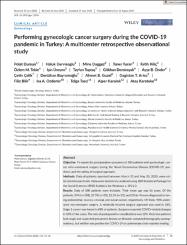Performing gynecologic cancer surgery during the COVID-19 pandemic in Turkey: A multicenter retrospective observational study

View/
Access
info:eu-repo/semantics/openAccessDate
2020Author
Dursun, PolatDervişoğlu, Haluk
Dağgez, Mine
Turan, Taner
Kılıç, Fatih
Tekin, Özlem M.
Üreyen, Işın
Toptaş, Tayfun
Demirayak, Gökhan
Önder, Ayşe B.
Çelik, Çetin
Bayramoğlu, Denizhan
Güzel, Ahmet B.
Arıöz, Dağıstan Tolga
Bilir, Filiz
Özdemir, İsa A.
Taşçı, Tolga
Karalök, Alper
Karateke, Ateş
Metadata
Show full item recordAbstract
Objective To report the perioperative outcomes of 200 patients with gynecologic cancer who underwent surgery during the Novel Coronavirus Disease (COVID-19) pandemic and the safety of surgical approach. Methods Data of patients operated between March 10 and May 20, 2020, were collected retrospectively. Data were statistically analyzed using IBM Statistical Package for the Social Sciences (SPSS) Statistics for Windows v. SP21.0. Results Data of 200 patients were included. Their mean age was 56 years. Of the patients, 54% (n=108), 27.5% (n=55), 12.5% (n=25), and 2% (n=4) were diagnosed as having endometrial, ovarian, cervical, and vulvar cancer, respectively. Of them, 98% underwent non-emergent surgery. A minimally invasive surgical approach was used in 18%. Stage 1 cancer was found in 68% of patients. Surgeons reported COVID-related changes in 10% of the cases. The rate of postoperative complications was 12%. Only two patients had cough and suspected pneumonic lesions on thoracic computed tomography postoperatively, but neither was positive for COVID-19 on polymerase chain reaction testing. Conclusion Based on the present findings, it is thought that gynecologic cancer surgery should continue during the COVID-19 pandemic while adhering to the measures. Postponement or non-surgical management should only be considered in patients with documented infection. Gynecologic cancer surgery should continue during the COVID-19 pandemic while adhering to measures. Only 1% of patients developed COVID-19-related symptoms during the postoperative follow-up period.















